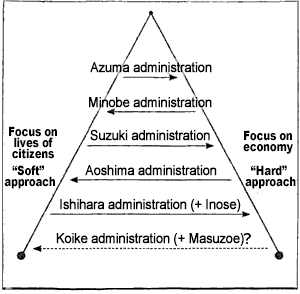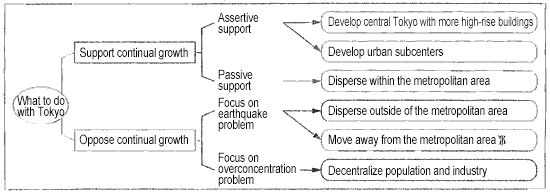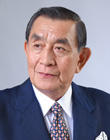Key Areas of Debate Surrounding the 2020 Tokyo Gubernatorial Election
Nobuo Sasaki
Professor Emeritus, Chuo University
Areas of Specialization: Public administration, local governmental autonomy
Tokyo has Arrived at a Turning Point
This year will mark a major turning point for Tokyo. The age of growth we've been experiencing will end, there will no longer be special demands for the Olympics, and various problems such as depopulation and the aging population of Tokyo will be surfacing.
This summer, the Tokyo Olympics, the bid for which started ten years ago, will finally be upon us. Starting with the Olympics opening ceremony on July 24, followed by 17 days of Olympics games and 13 days of Paralympic games, the whole event ends with the Paralympics closing ceremony on September 6.
Questions remain regarding why we should spend three trillion yen to host the Olympics during Japan's hottest season, but regardless, it will be a long period stretching over a month. I hope that it ends in success and without any problems such as intense heat waves, earthquakes, typhoons, or terrorist attacks.
On July 5, just before the Tokyo Olympics begin, the Tokyo gubernatorial race will take place.
As Yuriko Koike, the current governor, ends her term in office on July 30, she will be attending the Olympics opening ceremony as governor. Yet what happens afterward remains to be seen. Depending on the results of the gubernatorial race, the governor, who will fulfill the role of the host, may change. This shows the kind of confusion and instability that has dogged the Tokyo metropolitan government over the past decade or so.
This will be the 21st gubernatorial race in Tokyo since the end of the war. Up until Shintaro Ishihara's third-term run as governor 14 years ago, the Tokyo gubernatorial elections were held as terms of office expired, and were essentially the toast of the unified local elections held in April. However, governorships have since changed hands frequently like a revolving door. After his successful fourth-term run, Shintaro Ishihara resigned in a year and a half. His successor, Naoki Inose, resigned after one year, followed by Yoichi Masuzoe, who was also forced to resign after two years and four months. In short, the Tokyo metropolitan government was plagued by a series of short-lived governorships and confusion reigned.
Although it seems that Governor Koike is set to serve her full term in office no-one knows what the future holds. For half a century following the end of the war, Tokyo governorships from 1947 until the end of Shunichi Suzuki's term in 1995 were marked by full-term service and stability, with the role being filled by bureaucrats and scholars. However, the ensuing years have seen, excepting Naoki Inose, governorships filled by members of the Diet, including Yukio Aoshima, Shintaro Ishihara, Yoichi Masuzoe, and Yuriko Koike. This appears to have coincided with an age of disarray in the Tokyo metropolitan government.
| Terms in office | Governors and major policies | Days in office |
|---|---|---|
| 1 term | Yukio Aoshima (April 23, 1995-April 22, 1999) ・Cancelled the World City Expo Tokyo ・Vision of a recycling city |
1,461 |
| 3 terms + 1.5 years |
Shintaro Ishihara (April 23, 1999-October 31, 2012) ・Restrictions on diesel vehicle emissions ・Establishment of ShinGinko Tokyo ・New government budget system ・Holding of the Tokyo Marathon |
4,941 |
| 1 year | Naoki Inose (December 18, 2012-December 24, 2013) ・Successful bid for the 2020 Tokyo Olympics |
372 |
| 2 years and 4 months |
Yoichi Masuzoe (February 11, 2014-June 21, 2016) ・Cost reduction for Olympic facilities ・Distribution of the Disaster Preparedness Tokyo book |
861 |
| 3 years |
Yuriko Koike (August 2, 2016-Present) ・Measures addressing the children on the waiting list for nursery schools ・Postponement of the Toyosu Market move |
1,278 |
Figure 1
The Current State of "Ungoverned Political Theater "
The forthcoming Tokyo gubernatorial race in July will be the election that decides who will lead the Tokyo metropolitan government in the four-year period following the Olympics. After the Olympics, it is likely that we will experience an economic recession, and the public financing of Tokyo will become increasingly tight. Whoever is elected will govern over a wide range of problems, including Tokyo's aging population. The key point will be to not engage in frivolous, attention-seeking governance, but to ensure that top management functions in a stable manner, and can effectively take command of the metropolitan government.
If I had to describe the Tokyo metropolitan government in recent years, I would describe it as "ungoverned political theater." You could also call it a "conspicuous governorship" or "government that leaves citizens behind." It has been marked by showy performances for the media, and dotted with policies that seem to have been spontaneously pulled out of a hat, such as the plans for reusing the former Tsukiji Market site to build an international conference center. This kind of government is no longer of any use to us. The job of the metropolitan government is to protect the daily lives of citizens and to secure the safety of the city even if the activities of the government seem mundane.
On this point, the metropolitan government in the past decade or so have functioned not to serve the citizens, but to serve elections and governors. As this state of confusion continued, Tokyo lost its position as one of the great global cities that include New York, Paris, and London, and was overtaken by other cities in the Far East, namely Singapore and Hong Kong. Meanwhile, both the population and infrastructure are aging, and the risks posed by disasters like major earthquakes and torrential rain are on the rise. Will these circumstances provide an opportunity to return to a metropolitan government that can formulate and execute long-term strategies?
Who Should Lead the Post-Olympics Metropolitan Government?
In the gubernatorial race held four years ago, 21 candidates ran for governor, with the three major candidates being Yuriko Koike, Hiroya Masuda, and Shuntaro Torigoe. With 2.91 million votes cast for Koike, she won the election by a landslide. Masuda, who was the favored candidate of the ruling coalition, lost as the runner-up.
| Voting day | Winning candidate (number of votes) | Runner-up (number of votes) | Voter turnout | ||
|---|---|---|---|---|---|
| July 31, 2016 | Yuriko Koike | 2,912,628 | Hiroya Masuda | 1,793,453 | 59.73% |
Figure 2
What voters expected of the historic election of Tokyo's first woman to serve as governor was a transparent and stable government administration that focused on the lives of citizens. At first, the governor did seem to meet expectations. The shadowy aspects of the Ishihara administration, which could be called a black box of sorts, were demystified through policies such as making the metropolitan government more transparent, delaying the Toyosu Market move, and reviewing three of the Olympics facilities.
However, within a brief space of time, the Koike administration that followed was mired in confusion that exceeded the level of turmoil she was expected to bring under control. What solidified this current state was the Lower House election in the fall of 2017. She formed the Kibo no To (Party of Hope) in what was perhaps part of a bid for the seat of Prime Minister, and surged into that election in a way that swallowed up the Democratic Party. The result was a crushing defeat. Losing the trust of Tokyo's citizens, hope turned to despair, and the Koike administration that followed gave way to days of obscurity.
However, with the Tokyo Olympics approaching, the preparations for the major event rescued Koike by overshadowing her failures in managing and handling the metropolitan government. The media also neglected to shine a light on the problem.
However, it won't go as smoothly moving forward. An Olympics-centered government isn't what the metropolitan government is supposed to be; it must serve more than just a singular event. The real work starts now. The metropolitan governor must serve as a politician, an administrator, and a diplomat. The question remains as to whether the governor can fulfill all three of these roles. Whoever gets elected, the governor must: (1) take firm control over the governance of the massive Tokyo Government Office as the administrator; (2) put every effort into solving the problem of Tokyo's aging population, which impacts a wide range of issues; and (3) scale back the bloated metropolitan government, and review the relationships between the wards of Tokyo from a perspective of decentralization. The government must take on the challenges of this kind of structural reform.
The Tokyo Government Office often brags about their 15-trillion-yen budget and the 170,000 government employees as being on par with the entire nation of Sweden, but the age in which bigger is considered better is over. Tasks such as water-related infrastructure and transportation, which should ideally be handled by municipalities, take up about a third of the metropolitan government's responsibilities. These public enterprise sectors should just be privatized. More importantly, the next administration should focus on building a metropolitan government that formulates policies in an efficient manner, and is able to transform from being an operational government office to a policy-making government agency.
The Pendulum Effect of Metropolitan Government Transitions
If you observe the points of debate in this election, it looks like this one will not be dominated by single issues as it has in the past, such as whether a candidate supports or opposes the movement of Tsukiji Market, or whether they support the bid to host the Olympics. One of the issues set for debate will be whether to return to Diet support from the ruling coalition, or to continue with the Tomin First system as the political system. What must be avoided at all costs is to allow the current governor of the Tomin First party to join forces with the ruling coalition, effectively narrowing the range of candidates down to a single option. This would rob voters of the chance to have a say in policy, and cause the metropolitan government of the future to stagnate. What gets done is more important than who's in charge.
The metropolitan government works like a pendulum

Figure 3
The metropolitan government is the culmination of a series of policy debates. Every time the governorship switched hands, the government went back and forth between an economy-focused, "hard" approach to the livelihood-focused, "soft" approach, changing the content of government policy with each swing of the pendulum. However, partly due to the fact that the Koike administration has been focusing on preparations for the Olympics, it seems to be simply continuing the previous Ishihara administration's economy-focused, hard approach. The Masuzoe administration wanted to transition to a more livelihood-focused, soft approach, but their plans ended in obscurity after Masuzoe resigned. The Koike administration, which succeeded the Masuzoe administration, made grand declarations about the great reform of Tokyo, but the plans went no further than announcements.
Moving forward, the great metropolis Tokyo will experience the aging population problem in an unprecedented way. The tasks of securing social security for the millions of elderly citizens through services such as medical care, nursing care, welfare, and pensions, while also improving aging infrastructure, including roads, bridges, public facilities, subways, and water-related facilities will prove to be a major challenge. These are all things that come at massive costs. How do we generate such revenue? The metropolitan government needs major administrative reform. The next governor will be urged to make a bold policy shift toward a livelihood-focused, soft approach, whether they like it or not, and will also need to be closely involved in reforming the metropolitan government.
What to do with Tokyo: Reducing its Size by 20%
Another question is what function Tokyo should serve from a national perspective. Japan has split into two countries: Tokyo, with its increasing overconcentration, and the other regions, where depopulation continues to occur. Over 10% of Japan's population is concentrated in Tokyo, which only occupies 0.6% of the national landmass, with all high-level core functions, including those related to government, administration, economy, information, education, and culture being concentrated in three central wards dotting the map of Tokyo. It's said that a large-scale earthquake is certain to hit the Tokyo metropolitan area within the next 30 years; this could be as soon as this year or the next. As it currently stands, this will cause not just Tokyo, but the entire nation of Japan to fall into complete functional paralysis.
Major choices that Tokyo must make

Figure 4
Everyone seems to agree that the overconcentration of Tokyo is the root of all problems, but when pressed to come up with specific solutions, no clear answers arise. As the figure above illustrates, the issue hinges on whether Tokyo decides to support or oppose continual growth. This may, in fact, be the central debate. Of course, the metropolitan government lacks the authority to change Tokyo in major ways on its own, but it does have the power to restrict the construction of offices and high-rise condominiums that attract unlimited numbers of people. Policy choices will depend on what kind of future we want for Tokyo.
So, what if we reduced the size of Tokyo by 20%? We could reduce the population and the number of companies and universities by 20%, and slim down the size of the metropolis to 10 million people. What if we effectively utilize advanced technologies like AI and robotics to lift productivity and improve the quality of life in Tokyo? The goal would be to create a comfortable, spacious Tokyo with no traffic congestion or crowded trains. This would be a win-win situation for both Tokyo and the other regions.
No Tokyo governor in history has ever advocated such measures. However, with Japan now in the era of population decline, the idea of Tokyo succeeding on its own is outdated. The metropolitan government moving forward should be led by those who oppose the continual growth of Tokyo. This would revitalize the entire country, and reform Tokyo into a more comfortable urban space. I hope that the new governor will be someone who will strive to achieve this vision for Tokyo.
Nobuo Sasaki
Professor Emeritus, Chuo University
Areas of Specialization: Public administration, local governmental autonomy
Nobuo Sasaki was born in 1948. He graduated from the Graduate School of Political Science at Waseda University, and earned his Ph.D. in law at Keio University. He worked at the Tokyo Government Office for 16 years, and in 1989 became a professor at Seigakuin University, and then taught at Chuo University as a professor from 1994 to 2018. During this time, he worked as a visiting researcher at the University of California, then taught as a lecturer at Keio University, Meiji University, Nihon University, and Saitama University, and as a guest professor at Seigakuin University. He was a member of the 31st Local Government System Research Council, a member of the 22nd and 23rd Science Council of Japan, and a special advisor to the Osaka prefectural and municipal governments.
He is currently a professor emeritus at Chuo University, board chairman of the Nihon Kunizukuri Kenkyujo (the Japan Nation Building Research Institute), a special advisor to the Osaka prefectural and municipal governments, a visiting professor at Taiju Soken, and a guest professor at the Graduate School of Project Design.
Among his many publications are Oiru Tokyo (Aging Tokyo), Aratana Nihon no Katachi (The Shape of a New Japan), Chiho Giin no Gyakushu (The Revenge of the Local Representatives), Tocho (Tokyo Government Office), Doshusei (Administrative Reform Proposal), and Shichoson Gappei (Municipal Mergers). A new publication titled Kono Kuni no Tatamikata (How to Reform this Country) is coming soon.








